
William Carey, the famed author of the Dictionary of the Bengali Language, at the Serampore Mission, undertook a census in 1803 of suttees & counted 438 that had reportedly taken place that year within a thirty mile radius of Calcutta
Discovered in the hands
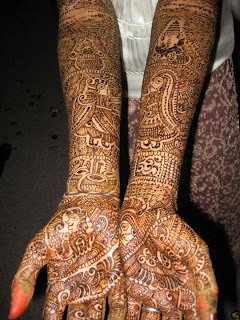
In a Hindu wedding the hands of the bride, groom & guests are lavishly decorated in henna art or mehndi.
Sometimes, hidden in the mehendi on hands of the bride, the groom has to discover his own name in the design on his wife's hands.
Sati (Sanskrit: सती / satī) is derived from the name of the goddess _Sati_, who
self-immolated because she could not bear her father Daksha's humiliation
of Shiva, her husband.
Some Hindu temples in India have walls marked red-henna handprints of young widows en route to their husbands' pyres. As a widow, the woman or child must throw herself to be immolated on the funeral pyre of her deceased husband . Religion & tradition decreed that they had to commit suttee.
All those hands
They were so small and
there were so many of them.
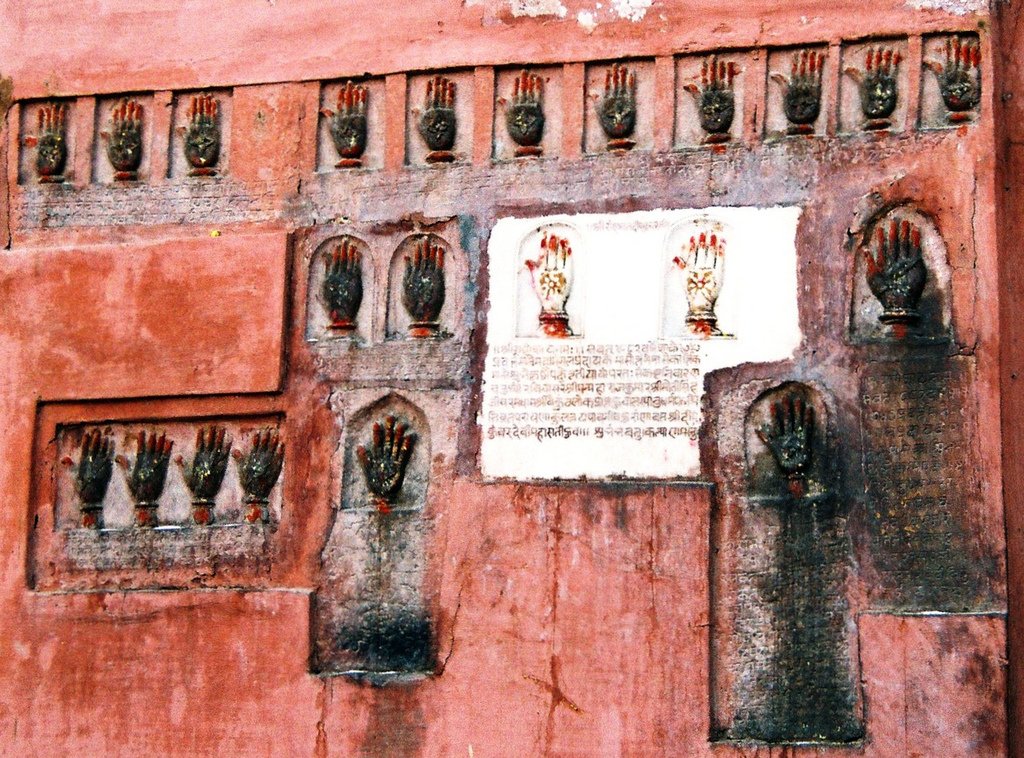
Hand prints of women who committed sati who were widowed when their husbands died in battle in defense of Junagarh Fort, Bikaner Dist, Rajasthan.
Sati originally designates the woman, rather than the rite.
The rite itself is called sahagamana ("going with") or
sahamarana ("dying with").

Mehrangarh Fort, Jodhpur.
Hand prints were made by wives & mistresses before throwing themselves or being forcibly thrown on the funeral pyre of their husband or master. For example, when Maharajah Ajit Singh died in 1731, six of his wives & 58 concubines were murdered on his funeral pyre.
The term sati was originally interpreted as "chaste woman".
In Hindi & Sanskrit texts, it is synonymous with "good wife".
Anglo-Indian English writers commonly used "suttee".
If the woman did not willingly consent to the ceremony, she was beaten & drugged to enforce compliance. If she changed her mind by sitting up in the flames to escape, she was beaten back down into submission with rods.

Suttee by James Atkinson, 1831 (India Office Collection of the British Library (c) British Library Board 2009)
William Carey & Raja Ram Mohan Roy
According to William Carey, the New Testament had a better program for the care of widows. In 1803, he submitted a detailed report to the Governor-General, Lord Wellesley, urging him to outlaw suttee. Since Wellesley took no action, Carey had to continue his crusade against sutte another 25 years.
At the same time, a priestly caste Hindu Brahim named Ram Mohan Roy, influenced by the New Testament morals & teachings of Jesus, founded the Brahmo Samaj: an institution which agglomerated Christian, Hindu, & Unitarian ideas. Raja Ram Mohan Roy joined in the war against suttee.

Bazaar art, from the earlier 1900’s, with two co-wives shown as satis
Anvarohana ("ascension" to the pyre) & satidaha designate the process.
Satipratha is a term signifying the custom of burning widows alive.
Sativrata, denotes the woman who makes a vow, vrat, to protect her husband
while he is alive and then die with her husband.
Satimata denotes a venerated widow who committed sati.
Under Lord William Bentinck, Carey & Roy were able to have suttee abolished in Bengal. William Carey, assigned to translate into Bengali the orders, completed the order on December 4,1829. Carey even missed a Sunday service to expedite the translation. Carey knew that every wasted day would cost more precious lives.
In 861, Queen Victoria issued a general ban for the whole of India. In Nepal banned sati in 1920.
The Indian Sati Prevention Act, 1988 has criminalised any type of aiding, abetting, and glorifying of sati.
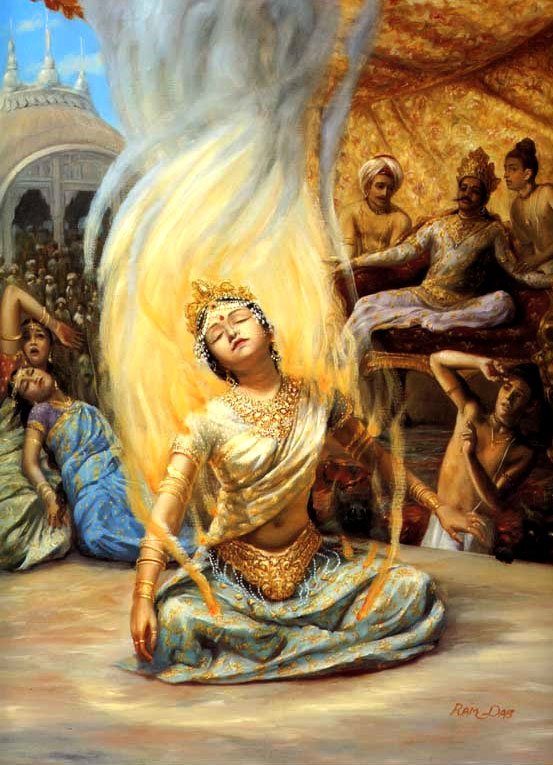
The self-immolation of Sati
Sativrata, denotes the woman who makes a vow, vrat, to
protect her husband while he is alive and then die with
her husband.
Satimata denotes a venerated widow who committed sati.
Sati Today
Sati is rarely discussed openly in modern India. Sati is alive & well in rural India, with
- Over forty documented cases since the 1950's
- Approximately one recorded incidence per year
- Anecdotal evidence suggesting a greater number of sucessful & unsuccessful sati attempts.
- Pro-sati advocates, generally men, still demand the right to commit, worship, & propagate sati.
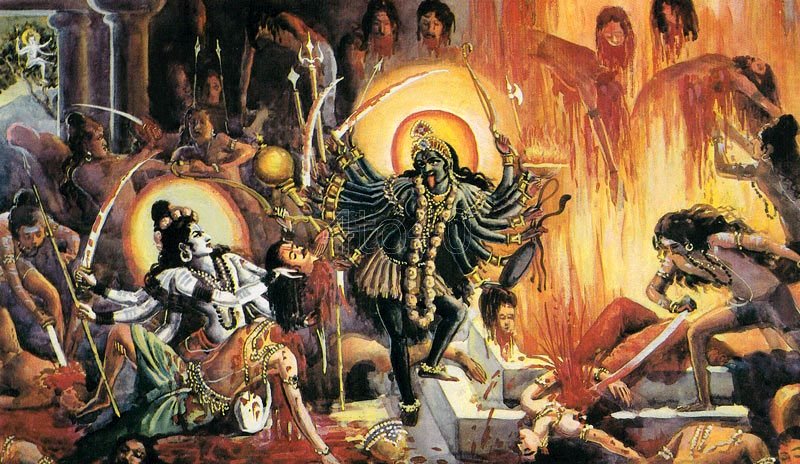
Daksha gets a goat head. Sati & Shiva transformation to Kali & Virabhadra starts.
Through sati, Kali enforces human sacrifice.
18-year old Roop Kanwar, 1987 village Deorala, Rajasthan.
Whether volunatary or coerced, several thousand people attended the immolation of Roop Kanwar. As she was hailed as a "pure mother", devotees from all over India flocked to her shrine to pay homage, bringing huge revenue & status to her village.
After Kanwar's death, the Sati Dharma Raksha Samti or Committee for the Defence of the Religion of Sati was formed run & supported by educated young Rajput men who stated that sati was a "fundamental" tradition. Refusing to legitimize sati, they said, was a deliberate attempt to marginalize the Rajputs.
Kanwar's sati led to:
The creation of state level laws to prevent the occurrence & glorification of future incidents .
The Commission of Sati (Prevention) Act 1987.
All 56 people charged with Kanwar's murder, participation in her murder or glorification of her murder during two separate investigations, were subsequently acquitted.
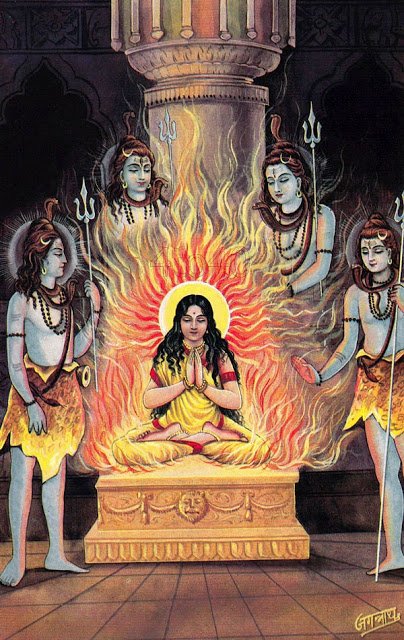
Sati Yogini
55 year old Charan Shah, 1999, Satpura village, Uttar Pradesh
Witnesses refused to co-operate with official investigations. It led triggered the publication of a vitriolic article justifying the practice of sati & demanding the repeal of the Commission of Sati (Prevention) Act. A respected female academic, Madhu Kishwar (published in Manushi, Issue 115) avocated for sati.
May 2006, 35 year old Vidyawati, Rari-Bujurg Village, Uttar Pradesh, allegedly jumped into the funeral pyre of her husband
August 2006, Janakrani, a 40-year-old woman, died on the funeral pyre of her husband in Sagar district. In October 2008,
75-year-old woman committed sati by jumping into her 80-year-old husband's funeral pyre at Checher in Raipur.
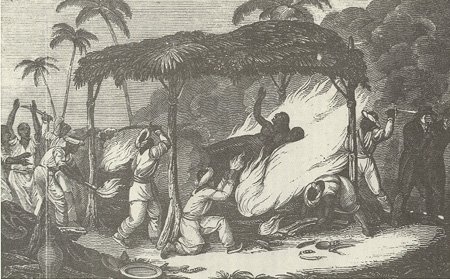
Burning of A Hindoo Widow, by James Peggs
Why learn about Kali?
Lest Satan should get an advantage of us: for we are not ignorant of his devices.
2 Cor 2:11, KJV
Much of the modern church, has been ignorant of Kali's schemes. This article & those to follow are a brief description of Kali, a history of her workings & her devastating worldwide impact.
For though we walk in the flesh, we do not war after the flesh:
(For the weapons of our warfare are not carnal, but mighty through God
to the pulling down of strong holds;) 5Casting down imaginations, and
every high thing that exalteth itself against the knowledge of God, and
bringing into captivity every thought to the obedience of Christ;
And having in a readiness to revenge all disobedience,
when your obedience is fulfilled.
2 Cor 10:3-6, KJV
We're called to educate ourselves
My people are destroyed for lack of knowledge: because thou hast rejected knowledge,
I will also reject thee, that thou shalt be no priest to me: seeing thou hast forgotten
the law of thy God, I will also forget thy children.
Hos 4:6
We need not have any fear: the Son of Man did not use His Son of Man override.
There is no fear in love [dread does not exist]. But perfect (complete, full-grown)
love drives out fear, because fear involves [the expectation of divine] punishment,
so the one who is afraid [of God’s judgment] is not perfected in love [has not grown
into a sufficient understanding of God’s love].
1 John 4:18 (AMP)
Such hope [in God’s promises] never disappoints us, because God’s love
has been abundantly poured out within our hearts through the Holy Spirit
who was given to us.
Romans 5:5 (AMP)
Further reading
Who is Kali?
Why was the Apostle Thomas murdered?
From Mongols to Mughals: How Kali came into great prominence in the Hindu pantheon
Kalikatta, Calcutta, Kolkata, the city of joy
The Thugees: The world's first Mafia or The world's deadliest secet society?
Sacrificing children to please the gods
Bonus Features
Relics of Sati

Sati jumps into the fire

On the sets of 'Devon Ke Dev Mahadev' - Sati inflammation scene

The Kali Series, Article 2.5
Based on Unmasking & Dethroning the goddess Kali by Jeshu Das, Calcutta, India
